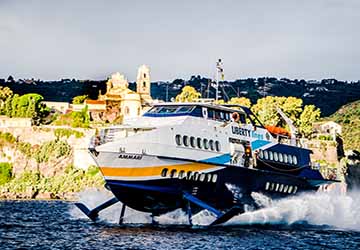
-
Recent Searches
Recent Searches
- Travel Alerts
- My Account
- Customer Service
-
United Kingdom
Stromboli to Vulcano Ferry
The Stromboli Vulcano ferry route connects Aeolian Islands with Aeolian Islands. Currently there is just the 1 ferry company operating this ferry service, Liberty Lines Fast Ferries. The crossing operates up to 35 times each week with sailing durations from around 1 hour 25 minutes.
Stromboli Vulcano sailing durations and frequency may vary from season to season so we’d advise doing a live check to get the most up to date information.
Average Stromboli Vulcano Prices
Prices shown represent the average one way price paid by our customers. The most common booking on the Stromboli Vulcano route is a car and 1 passenger.
Stromboli Guide
The small island of Stromboli is located in the Tyrrhenian Sea, just off the north coast of Sicily, Italy. The island is one of the Aeolian Islands and is the location of one of three active volcanos in Italy. For visitors to the island there are a number of things to do. You can stroll through the main village on the island and take in the lovely views. Alternatively, Stromboli is the perfect location for a boat ride around the island. From the sea the volcano is clearly visible with its steep black, lava scared, side. Finally, and this is for the more active, and perhaps brave, visitors, you can actually climb the volcano and get a much closer look at the crater and the eruptions.
There are some ferry and hydrofoil services from Sicily and the mainland that stop at Stromboli. Alternatively travellers can change on the island of Lipari for a connecting ferry. Stromboli is north-east of the other Aeolian Islands, and the hydrofoils from Lipari can take as much as 1 hour and 40 minutes. Services from Messina in Sicily take just under 1 hour and 30 minutes.
Vulcano Guide
The small Italian island of Vulcano lies in the Tyrrhenian Sea and is roughly 25 km off the coast of the island of Sicily. It is the southernmost of the eight islands that make up the Aeolian group of islands. The island has a number of volcanic centres, including one of four active, non-submarine, volcanoes in Italy. The most recent volcanic activity on the island was at the Gran Cratere at the top of the Fossa Cone, with the cone having grown in the Lentia Caldera in the middle of the island, and has had around 9 major eruptions in the last 6,000 years. However, since the eruption of the Fossa Cone between 1888 and 1890, which deposited around 5 meters of material on the summit, the island has been quiet. For the brave, visitors are able to walk to the crater of a volcano where you can observe smoke coming out of the ground! Apart from the volcanos the island is popular with tourists because of its hot springs which are only a short walk from the island's harbour.


